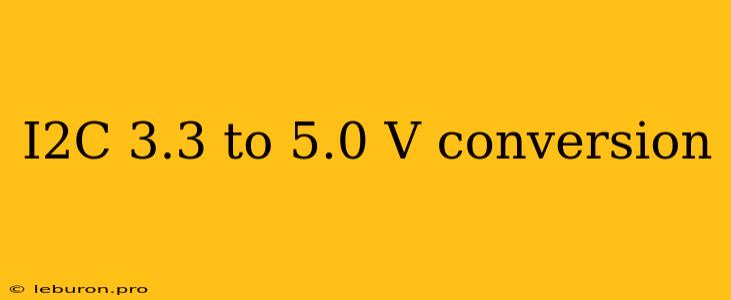Bridging the Gap: I2C Communication Between 3.3V and 5.0V Systems
The ubiquitous I2C (Inter-Integrated Circuit) communication protocol, known for its simplicity and flexibility, is commonly used in a wide range of embedded systems. However, the prevalence of different operating voltage levels (3.3V and 5.0V) can pose a challenge when interfacing devices with varying power requirements. This article delves into the crucial need for I2C 3.3 to 5.0V conversion and explores practical solutions to ensure seamless communication between these distinct voltage domains.
Understanding the I2C Protocol and Voltage Levels
The I2C protocol, as the name suggests, was initially designed for communication between integrated circuits. Its simplicity lies in the use of just two wires: SDA (Serial Data) and SCL (Serial Clock). Data is transmitted serially using a master-slave architecture, where a master device initiates communication and controls the data flow while slave devices respond to the master's requests.
While the I2C protocol itself is voltage-agnostic, the actual implementation of the communication relies on the voltage levels present in the circuit. This is where the incompatibility between 3.3V and 5.0V systems becomes apparent. A device operating at 5.0V will send high signals at approximately 5V, while a device operating at 3.3V will only reach 3.3V for a high signal. This mismatch can cause misinterpretations in data transmission.
Challenges of Direct Connection Between 3.3V and 5.0V Devices
Connecting a 3.3V device directly to a 5.0V device can lead to several issues:
- Data Corruption: If a 5.0V device sends a high signal to a 3.3V device, the voltage might exceed the 3.3V device's input threshold, resulting in data corruption.
- Device Damage: In some cases, a high voltage signal from a 5.0V device could damage the 3.3V device's input circuitry.
- Incorrect Logic Levels: A 3.3V device sending a high signal to a 5.0V device might not reach the 5.0V device's high threshold, causing the signal to be misinterpreted as a low signal.
Solutions for I2C 3.3 to 5.0V Conversion
Fortunately, several solutions exist to overcome the voltage incompatibility issue in I2C 3.3 to 5.0V conversion. These solutions can be categorized into two primary approaches:
1. Hardware-Based Solutions
- Level Shifters: Level shifters are dedicated integrated circuits designed to convert logic levels between different voltage domains. They function by translating the input voltage to the desired output level, ensuring compatibility between the devices. Popular level shifter ICs include the 74LC245 and the BAV99.
- Logic Gate Arrays: Logic gate arrays, such as the 74HC244, can be used to create a simple level shifter circuit. This approach requires connecting the logic gates in a specific configuration to achieve the desired voltage conversion.
2. Software-Based Solutions
While hardware-based solutions offer a straightforward and robust approach, software-based solutions can be used in certain scenarios:
- Pull-Up Resistors: In some cases, adding a pull-up resistor with an appropriate value can help raise the voltage level of the signal transmitted from a 3.3V device to meet the 5.0V device's requirements. This approach is effective when the signal is only slightly below the required threshold.
- Microcontroller I/O Pins: Some microcontrollers offer I/O pins with adjustable voltage levels. By configuring these pins to operate at 5.0V, it becomes possible to communicate with 5.0V devices directly.
Considerations for Choosing an Approach
The choice of approach depends on factors such as the specific application, the number of I2C lines to be converted, and the cost considerations.
- Level shifters are generally the preferred option due to their simplicity, availability, and reliability. They are particularly suitable for situations where multiple I2C lines need to be converted.
- Logic gate arrays provide a more flexible solution, allowing for customized designs. They are suitable for smaller projects where cost is a concern.
- Software-based solutions are suitable for specific scenarios where the voltage difference is minimal and hardware-based solutions are not practical.
Implementing I2C 3.3 to 5.0V Conversion
Here's a simple example of using a level shifter (74LC245) to achieve I2C 3.3 to 5.0V conversion:
- Connect the SDA and SCL lines from the 3.3V device to the input pins of the 74LC245.
- Connect the output pins of the 74LC245 to the SDA and SCL lines of the 5.0V device.
- Provide appropriate power supply for both devices and the level shifter (3.3V for the 3.3V device, 5.0V for the 5.0V device, and the level shifter's specified voltage).
- Ensure that the level shifter is properly configured to operate in the desired direction (3.3V to 5.0V or vice versa).
Conclusion
Effectively implementing I2C 3.3 to 5.0V conversion is essential for ensuring smooth communication between devices operating at different voltage levels. Whether opting for a hardware-based solution like level shifters or a software-based approach, understanding the challenges and solutions is crucial. By carefully considering the specific requirements of the application and selecting the most appropriate method, developers can overcome the voltage incompatibility barrier and enjoy the benefits of I2C communication across diverse systems. The I2C 3.3 to 5.0V conversion process is a key step in maximizing the versatility of I2C communication in embedded systems, enabling developers to integrate devices with varying power requirements and expand the possibilities of their projects.
